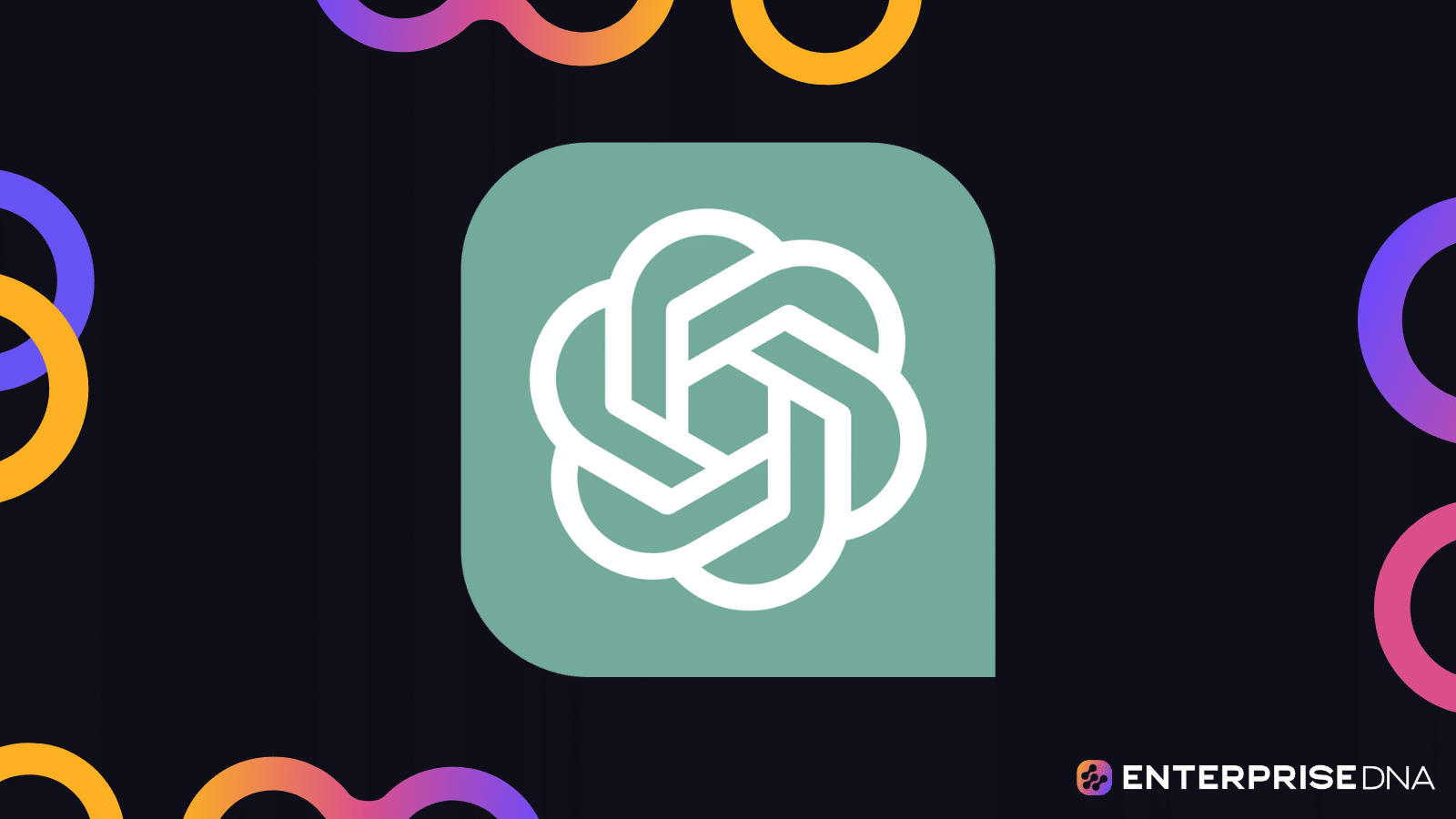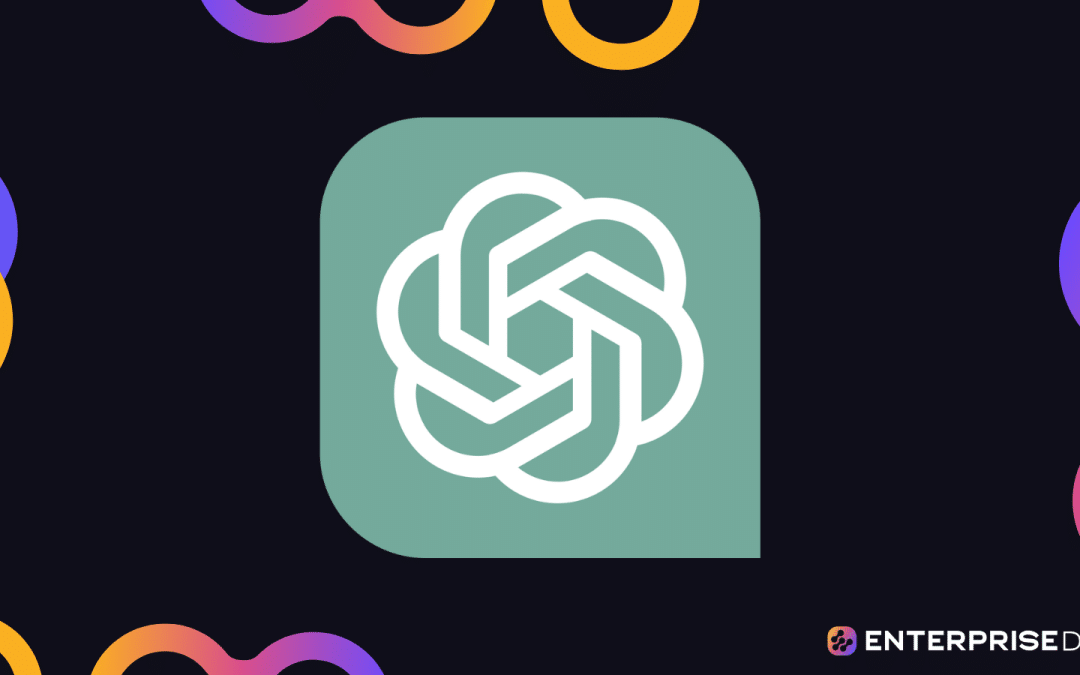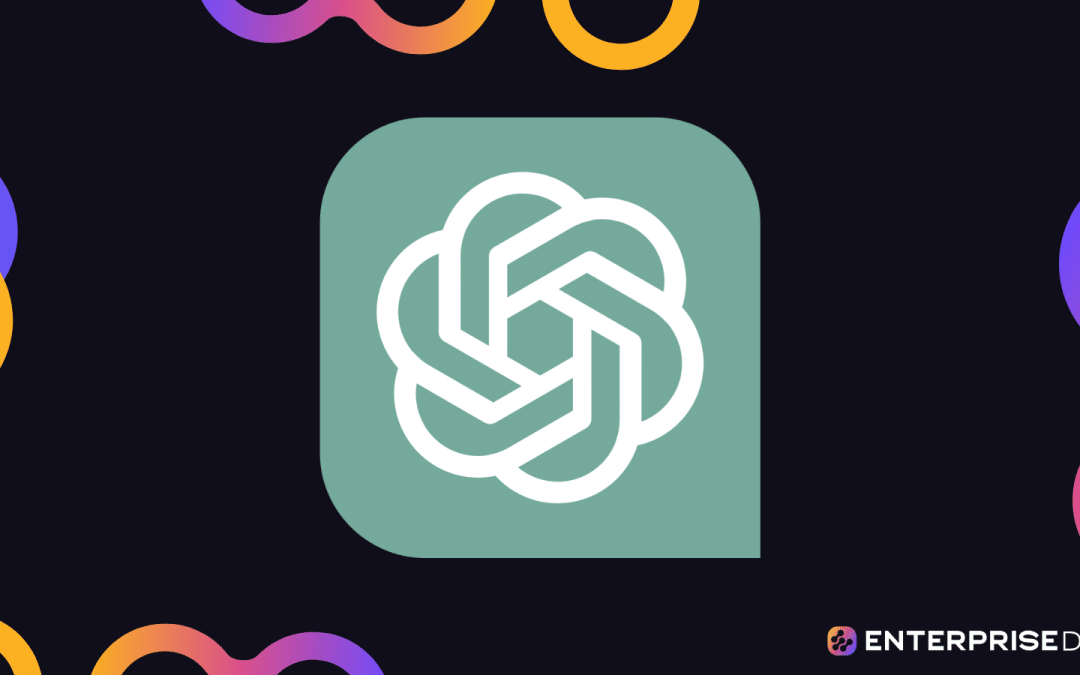Artificial intelligence (AI) and natural language processing (NLP) have revolutionized how developers create engaging and dynamic experiences for their users. One of the most powerful tools in this domain is ChatGPT, an advanced language model that can generate human-like text.
To use Chat GPT for Python, you can install the OpenAI API client and create an API key. Once you have the API key, you can integrate ChatGPT directly into your applications using environment variables or ChatGPT’s messaging prompt to ask for help writing and fixing your code.
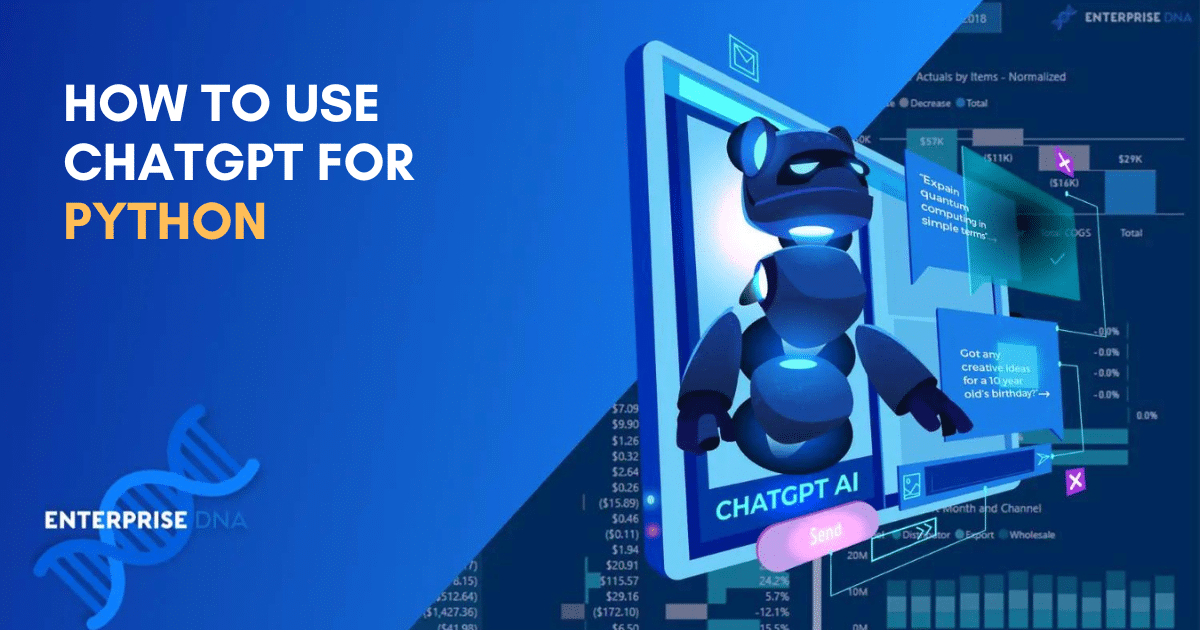
In this article, we will explore the steps required to work with ChatGPT in Python. Furthermore, we will also go over specific command prompts that are helpful when using ChatGPT’s messaging prompt.
Let’s get into it!
2 Steps for Getting Started with ChatGPT for Python
To begin, you will need to install Python on your system so that you can write and execute Python scripts seamlessly.
Next, add ChatGPT’s API to your Python applications. It’s as simple as importing any other Python library into your project.
To integrate Chat GPT and generate text, you must create an API key and install OpenAI’s client.
Let’s look at how you can create an API key for interacting with ChatGPT in Python.
Step 1. Creating a ChatGPT API Key
To use ChatGPT with Python, you need to create and obtain an API key from OpenAI. Follow these steps:
Sign up or log in to your account on the OpenAI website.
Navigate to the API Keys section and click on View API Keys.
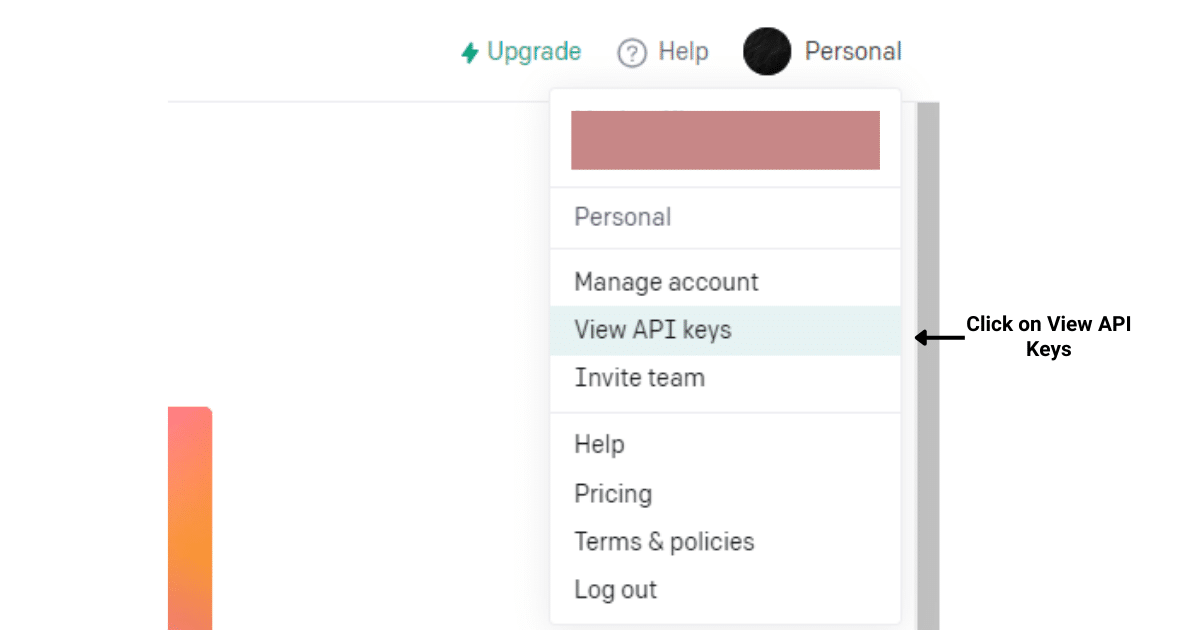
3. Click on Create New Secret Key.
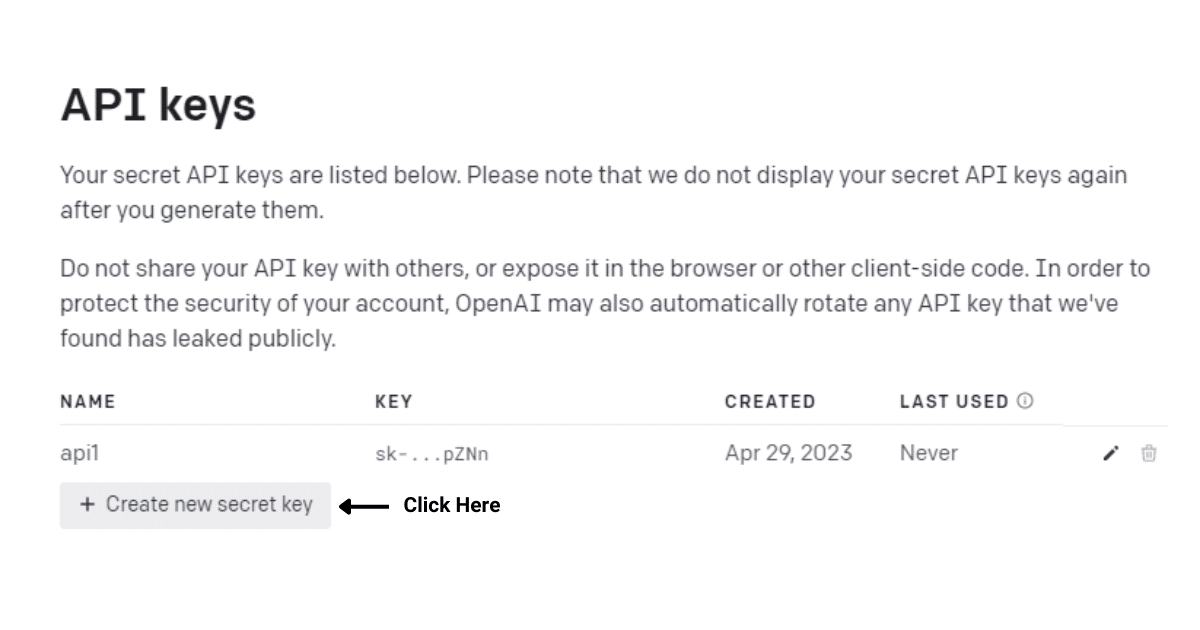
4. Give your key a unique name and click Create New Key.
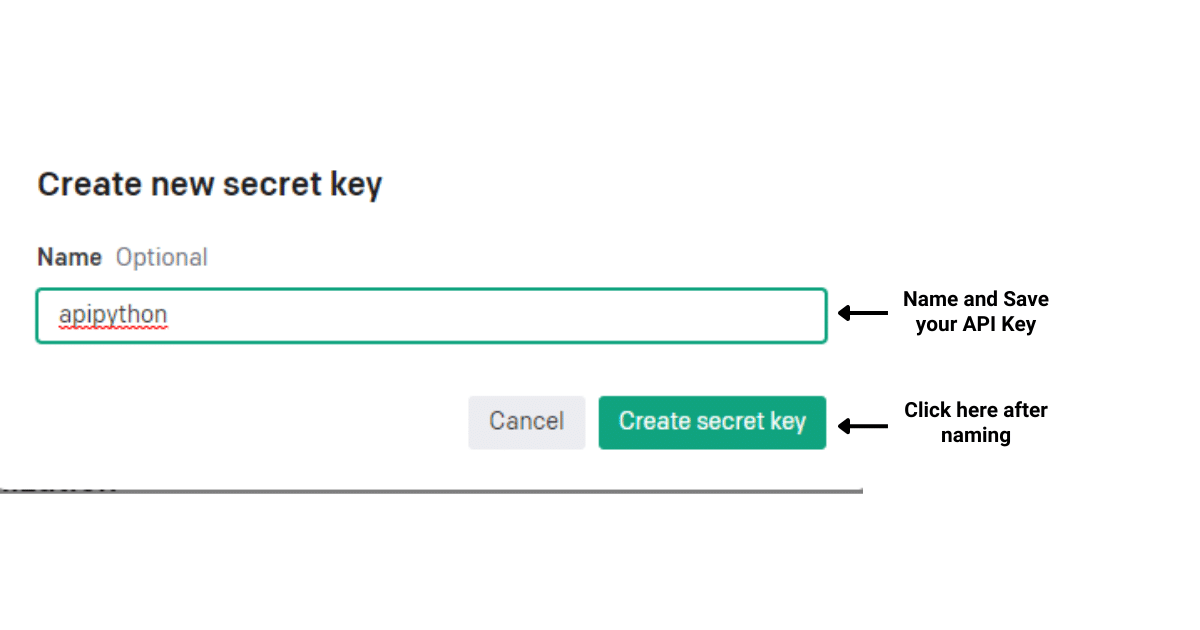
5. Now, you can copy and use your newly generated secret key in your applications.
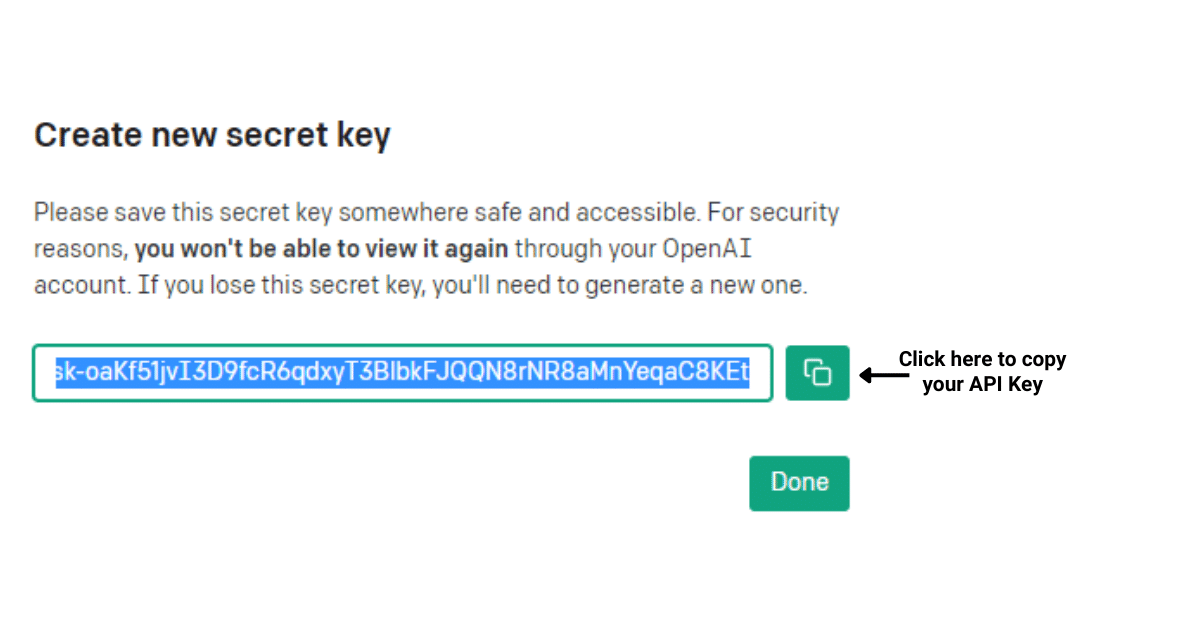
And you’re set! Now that you have your API key, you’re reading to install the OpenAI API client, which is what we’ll cover in the next section.
Step 2. Installing the OpenAI API Client
With your API in hand, you’re now ready to install the OpenAI API client. You will use this client to interact with the ChatGPT API.
Install the client using pip, the Python package manager, in your environment:
pip install openai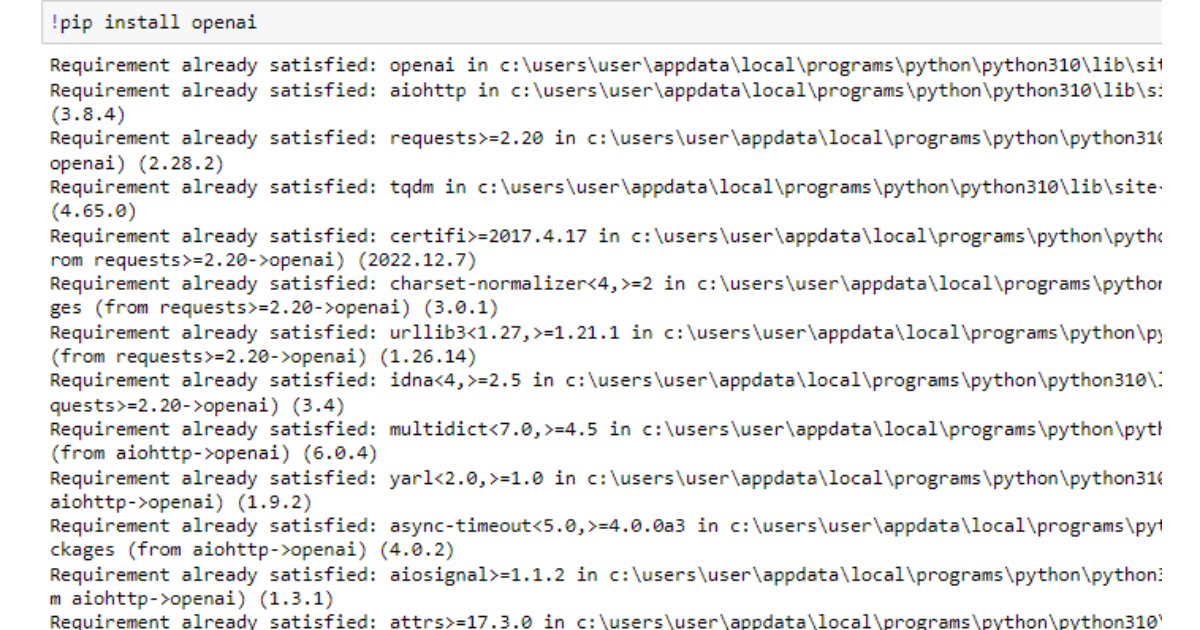
After installing the client, you need to import it to your current project by using the command given below:
import openai
openai.api_key = "your_api_key_here"Replace “your_api_key_here” with your actual openai API as shown in the image below.
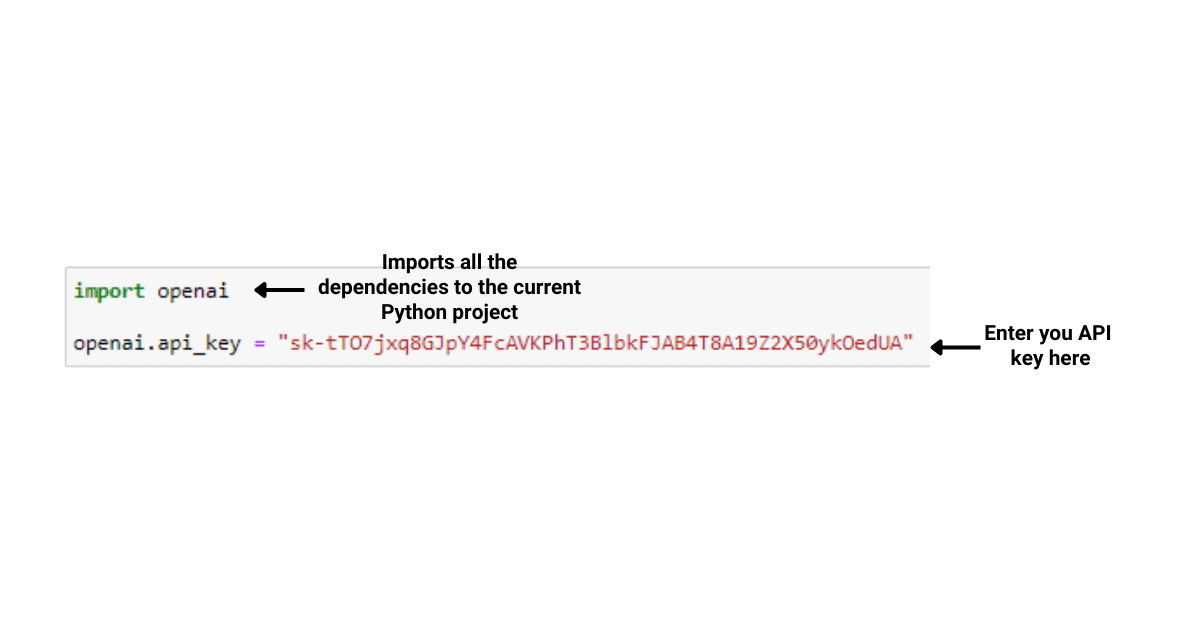
And that’s it! You can now access ChatGPT and create Python apps that harness its NLP powers.
In the next section, we’ll take a look at an example of the API key in action with Python. Let’s jump into it and get our hands dirty!
How to Use ChatGPT API with Python?
Now that you have an API key from OpenAI, let’s examine an example of using Chat GPT API within Python scripts, demonstrating the power of this programming language and its ability to integrate with advanced AI models.
The most common application of Chat GPT within Python is to create a chatbot, so let’s explore how you can create a chatbot within your Python environment using the ChatGPT API.
By harnessing the power of Chat GPT, you can build chatbots that can provide helpful assistance and engage users in dynamic conversations too.
You’ll also be able to generate text outputs tailored to users’ needs, all within the versatile Python programming language.
Creating a Chatbot With the ChatGPT API in Python
To create a chatbot using ChatGPT API with Python, first define a function that interacts with the Chat GPT API. For this example, we’ll be using the GPT-3.5-turbo model.
The following is a simple function to send messages to the ChatGPT API and receive a response:
import openai
def chat_with_chatgpt(prompt, model="gpt-3.5-turbo"):
response = openai.Completion.create(
engine=model,
prompt=prompt,
max_tokens=100,
n=1,
stop=None,
temperature=0.5,
)
message = response.choices[0].text.strip()
return message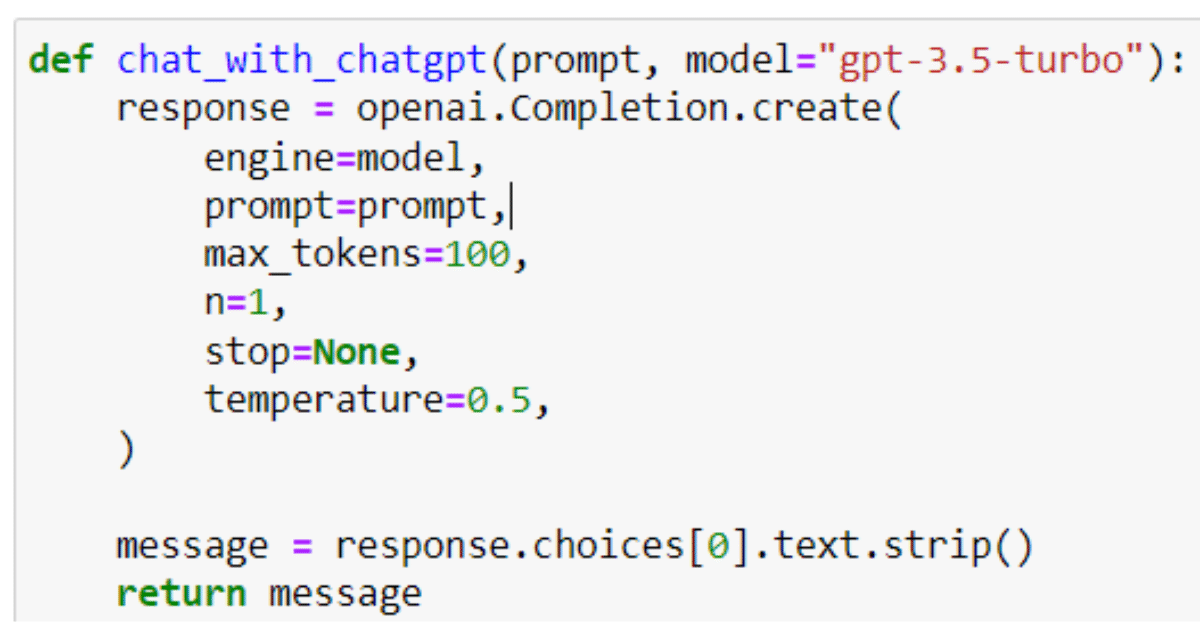
The above Python script imports the OpenAI library and defines a function chat_with_chatgpt that takes a user prompt and uses the OpenAI API to generate a response using the specified ChatGPT models. The function returns the generated response as a text message.
Now, you can call the chat_with_chatgpt function with user input, and the following command will return the generated response:
user_prompt = "Write a summary of the benefits of exercise."
chatbot_response = chat_with_chatgpt(user_prompt)
print(chatbot_response)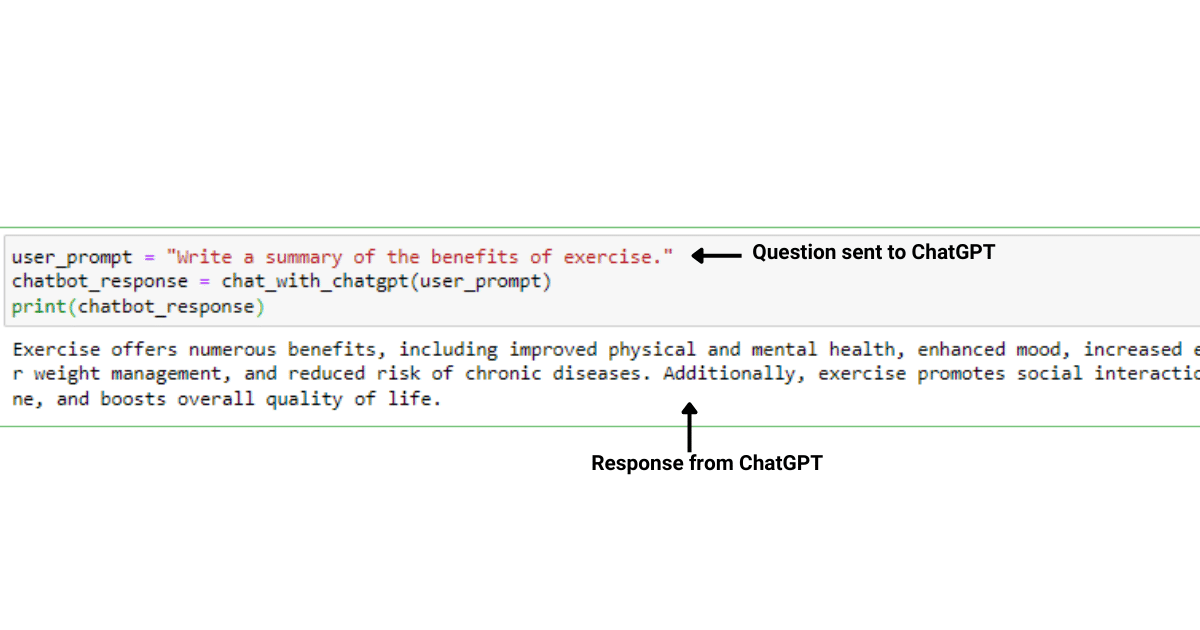
With this setup, you have now integrated Chat GPT into your Python application, enabling you to create a wide range of generated text-based interactions using the ChatGPT model.
You can also adjust the parameters to your liking depending on your project requirements. For more information on API parameters, please refer to the developer documentation.
So that’s one example of using ChatGPT’s API in Python code. The goal was to get you started on using ChatGPT in Python, which you can further scale depending on the project at hand.
In the next section, we will look at using ChatGPT’s messaging prompt for writing Python code.
Ready to Learn ChatGPT Tips, Tricks & Hacks?
Join 43,428+ others on our exclusive ChatGPT mailing list; enter your details below.
Sign up for our exclusive newsletter below, join 3,647+ others in staying ahead of the competition with ChatGPT!
[wpforms id=”211279″]
4 Examples of How to Use ChatGPT in Python Code
With the advent of Chat GPT, developers across the globe are using its messaging prompt to not only write better code but to reduce the time it takes to write code.
I mean, who doesn’t want to save time when writing code?
In this section, we will look at four examples that will give you an understanding of using ChatGPT to write complex code and boost your productivity when developing applications or working with data in Python.
[wpforms id=”211279″]
Example 1: Asking ChatGPT to Write Complex Algorithms
With ChatGPT, you can write the most complex algorithms in Python that would previously take hours to write.
All you have to do is ask ChatGPT through its command prompt or command line prompt to write you a particular algorithm, and voila, it will write the code for you in no time.
Let’s ask ChatGPT to write code for finding the longest common subsequence of two strings. The Longest Common Subsequence (LCS) algorithm is useful for identifying similarities between sequences.
It is commonly applied in bioinformatics for comparing DNA, RNA, or protein sequences, and in text processing for detecting similarities, measuring the edit distance between strings, or implementing diff tools.
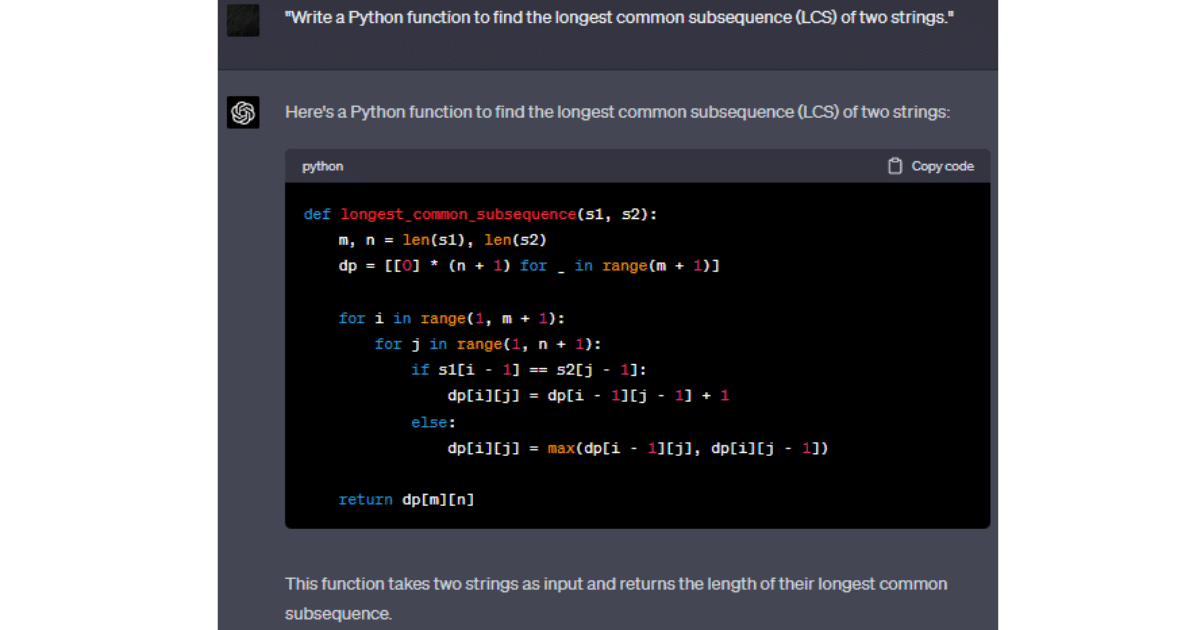
You can copy the code to your Python project and change it according to your specific needs.
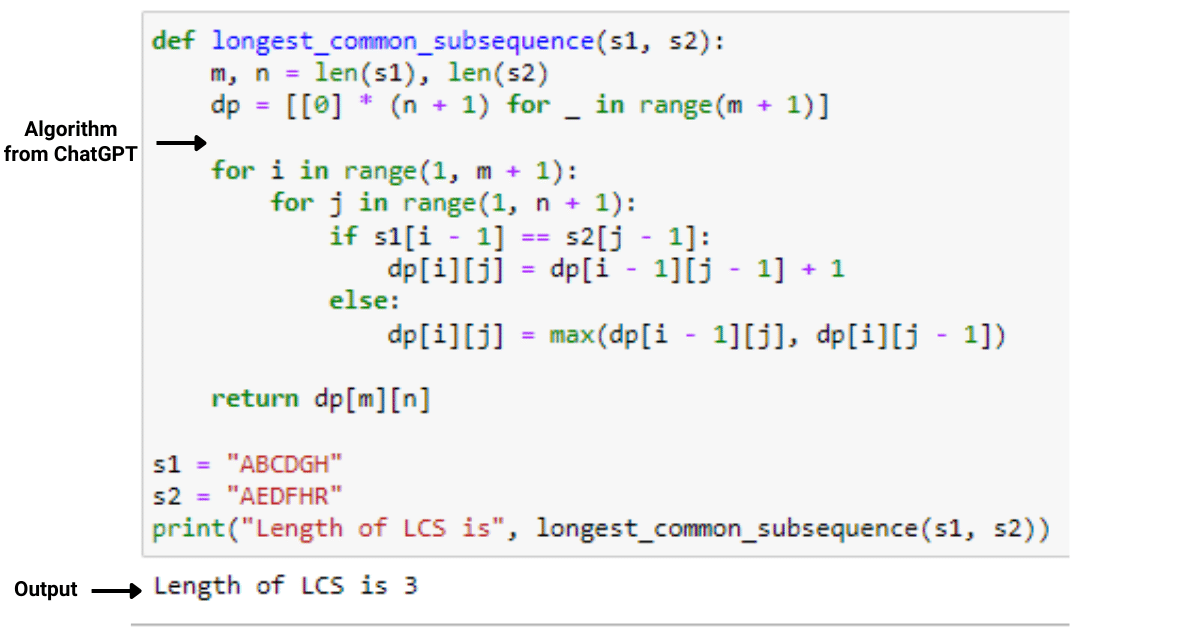
Example 2: Asking ChatGPT to Write Code for Web Scraping
Writing code for scraping websites can be daunting; however, with ChatGPT, you can minimize the time it takes to write code for web scraping.
The example below demonstrates how you can extract all headings from a webpage using the BeautifulSoup library:
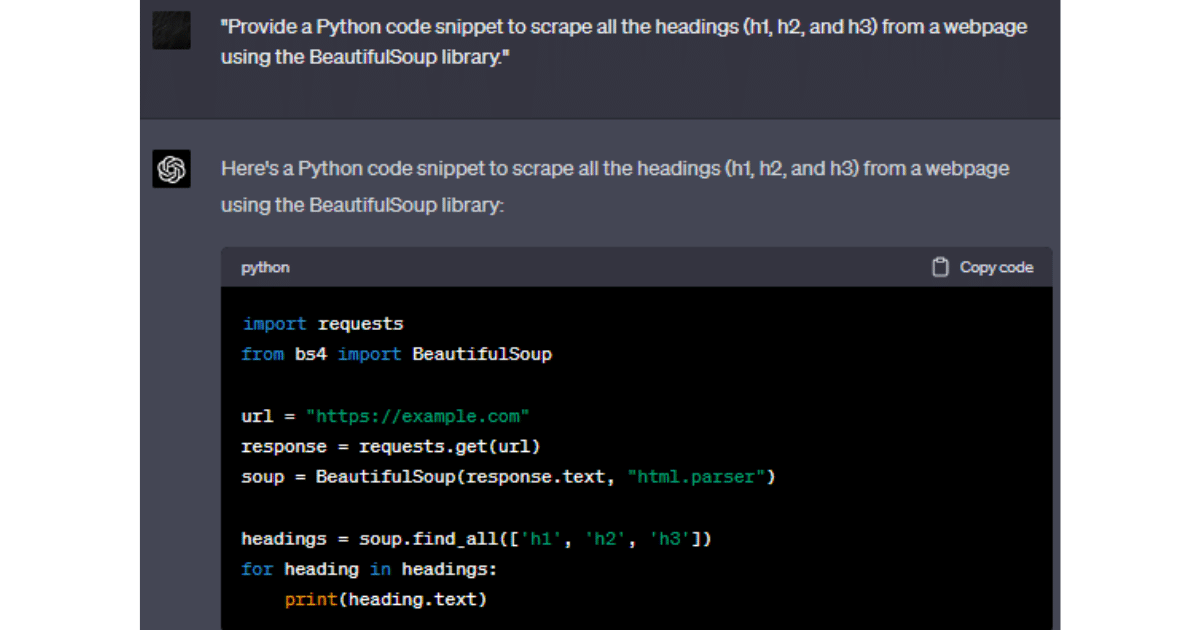
When implementing the above code in your Python project, you just need to change the URL to the website you are scrapping. You can further scale the above code by asking ChatGPT to modify the code in case you are scrapping something other than the website headings.
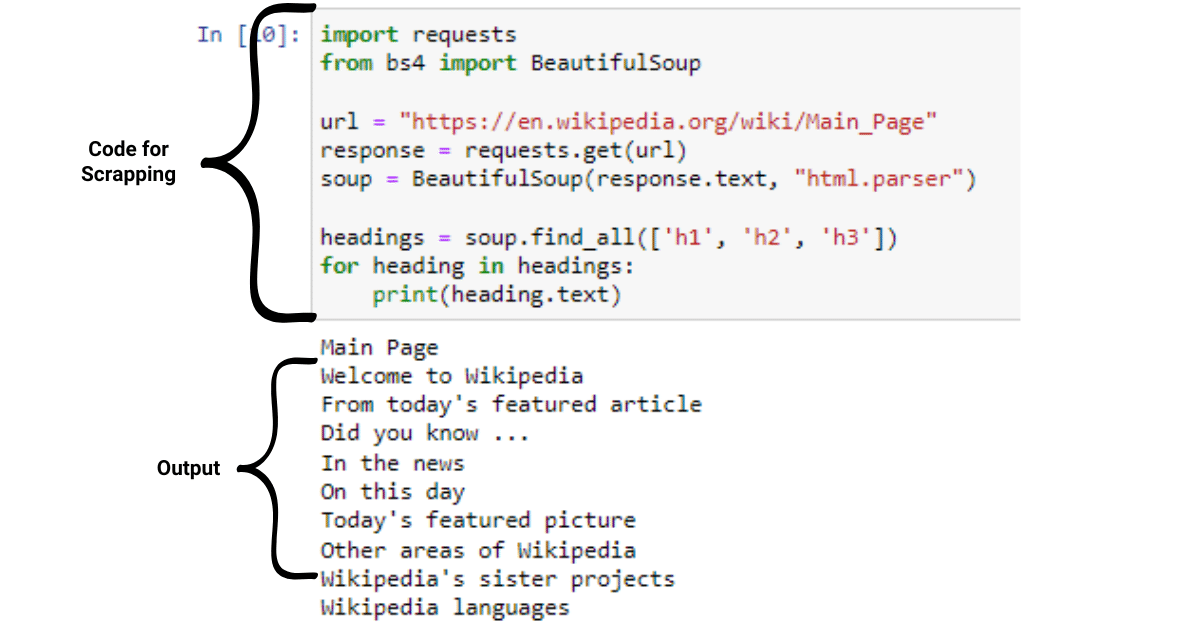
Example 3: Asking ChatGPT to Write Python Script for Data Analysis
You can use ChatGPT to write code for data analysis tasks as well. In the following Python program, we used ChatGPT to import, filter and find the mean from a dataset.
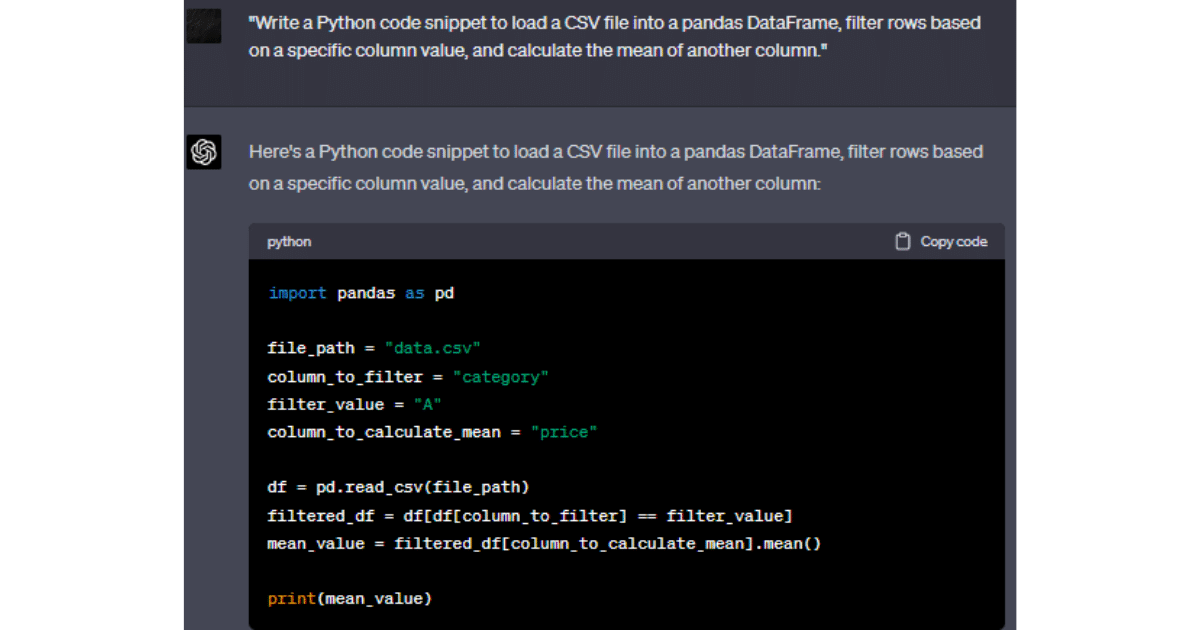
Once the code is written, copy it to your Python project and make changes according to your needs.
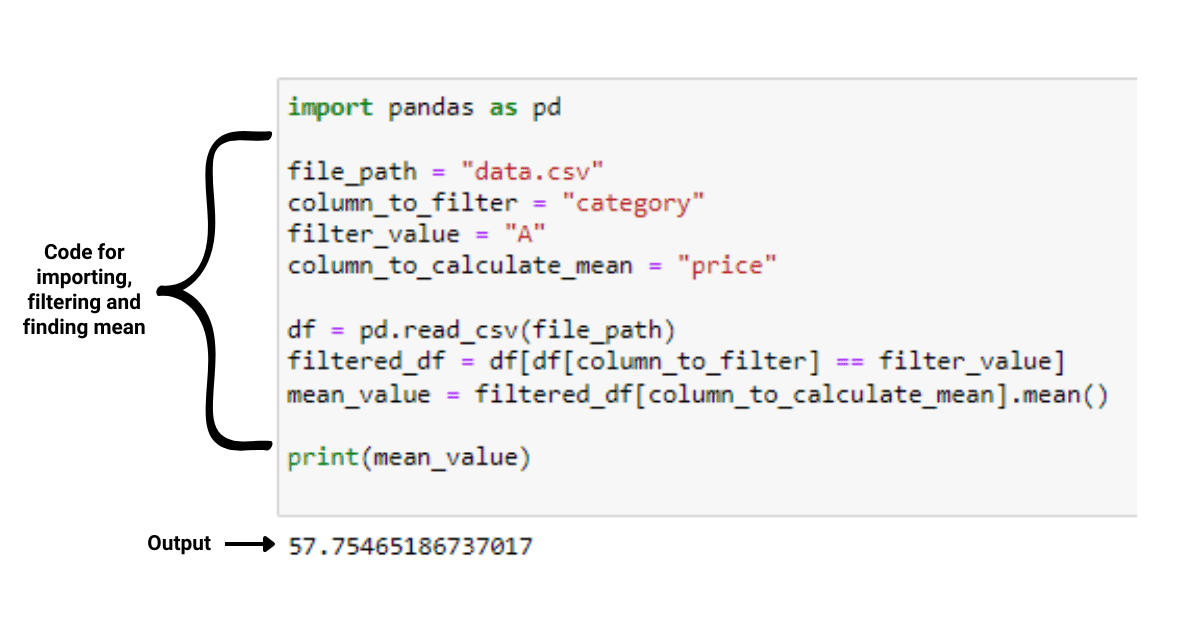
Furthermore, you can create the most complex machine learning models with ChatGPT, such as Decision Trees and Logistic Regressions, and use them in your Python code.
To learn more about data analysis with Python, check the following video out:
Example 4: Asking ChatGPT to Create Web Apps Using Flask
With ChatGPT, you can write code for creating web applications using Python. The example below demonstrates how you can create a very basic web app that returns ‘Hello, World!’ as the response:
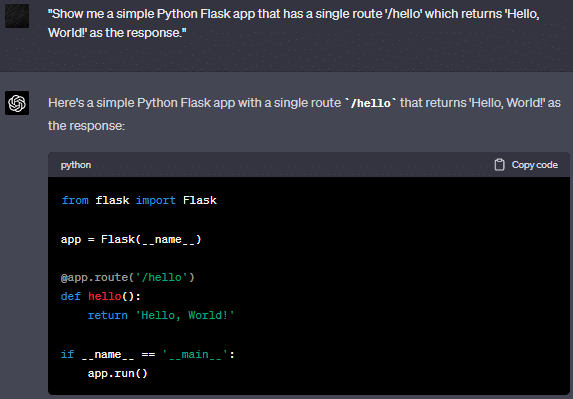
This example provides an easy-to-understand starting point for beginners learning web development or working with Flask.
It showcases how to define a route and its corresponding function, which can be further built upon and extended to create more complex web applications with multiple routes and functionalities.
All the examples provided demonstrate the power and versatility of ChatGPT in generating Python code snippets for various tasks. By utilizing ChatGPT, developers can quickly receive assistance in creating solutions for complex problems or even simple functions.
These examples not only showcase the potential of ChatGPT for enhancing productivity but also highlight its ability to act as an educational tool for learning different aspects of Python programming.
Is the Code ChatGPT Generates Correct?
From our experience, most of the time, it is. But, and this is a big but, nothing beats solid learning and real-world experience to cross-check things.
This could change and it most probably will, but for now, we suggest always double-checking what you do and using ChatGPT to enhance what you do, not replace learning!
Ready to Learn ChatGPT Tips, Tricks & Hacks?
Join 43,428+ others on our exclusive ChatGPT mailing list; enter your details below.
Sign up for our exclusive newsletter below, join 3,647+ others in staying ahead of the competition with ChatGPT!
[wpforms id=”211279″]
Final Thoughts
Throughout this article, we have explored the benefits of using ChatGPT for Python development, from integrating it directly into applications to leveraging its messaging prompt for code assistance.
By using ChatGPT, you can improve productivity, create complex algorithms, and access a solid educational tool for assisting in learning various aspects of Python programming.
Importantly, you must strike a balance between relying on ChatGPT and learning alongside it. This ensures that you not only receive assistance from ChatGPT but also develop a deeper understanding of the underlying concepts and programming principles. We don’t want our brains turning to mush, we need them, and they need us!
Hopefully, the examples in this article have given you a good starting point of how our new friend ChatGPT can write better code in record time.
By embracing this advanced language model and using it as a complementary resource, you can significantly enhance your programming efficiency, deepen your understanding, and create some killer code, enjoy!

